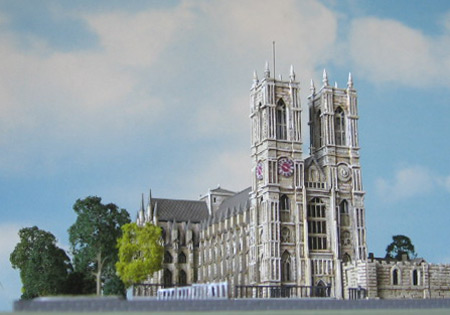
WESTMINSTER ABBEY
. London, England .
8" x 11" x 4.5" Tall

WESTMINSTER ABBEY
. London, England .
8" x 11" x 4.5" Tall
|
Westminster Abbey (whose formal name is the Collegiate Church of St Peter, Westminster) is the site for royal coronations and royal entombments, and holds more history than almost any building in London. It's history goes back more than a thousand years. Benedictine monks first came to this site in the middle of the 10th century, and established a tradition of daily worship which continues to this day. Located next to the Houses of Parliament in the neighborhood of Westminster, the abbey's oldest parts date to the year 1050. The present church, begun by Henry III in 1245, is one of the most important Gothic buildings in the world, and one of the greatest examples of church-architecture on earth. The original Abbey, in the Romanesque style, was begun by Edward the Confessor in 1045-1050 to house Benedictine monks. It was rebuilt in the Gothic style between 1245-1517 and organized by Henry III as a shrine to honor Edward. The work was largely finished by the architect Henry Yevele in the reign of King Richard II. The two twin towers were built between 1722 and 1745 by Sir Christopher Wren in Gothic Revival style. At the back of the church, the Henry VII Chapel was added in the 16th century. It is considered one of the loveliest in Europe. To the south of the church numerous church buildings have either been incorporated or added, including the Cloisters, a Museum, and the beautiful octagonal Chapter House dating to 1250. The gardens are the earliest gardens continuously in use, in London. Since the coronation of William the Conqueror in 1066, all English monarchs have been crowned in the Abbey. The several who were not crowned here, did not actually have coronations. The oak coronation throne where English monarchs have been crowned since the 1300s can still be seen in the Abbey. And History buffs will enjoy seeing the tombs of 17 monarchs, including Elizabeth I, Mary of Scotland and Henry V, as well as the tombs of Chaucer, David Livingstone, Charles Darwin, Milton, Pope, Browning, and England's Grave of the Unknown Warrior. Edward the Confessor, was canonized in the 12th century and his shrine in considered the most hallowed spot in the Abbey. Artist's Note: I am frequently asked how long it takes to make a miniature? Generally I don't keep up with this information. But with Westminster Abbey, I did keep up with the time, and it took 6 weeks, working 7 days a week, 8 to 10 hours a day. - Gene Gill |
| CLOSE THIS PAGE |